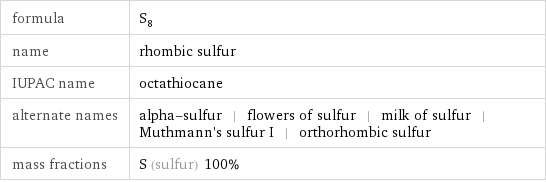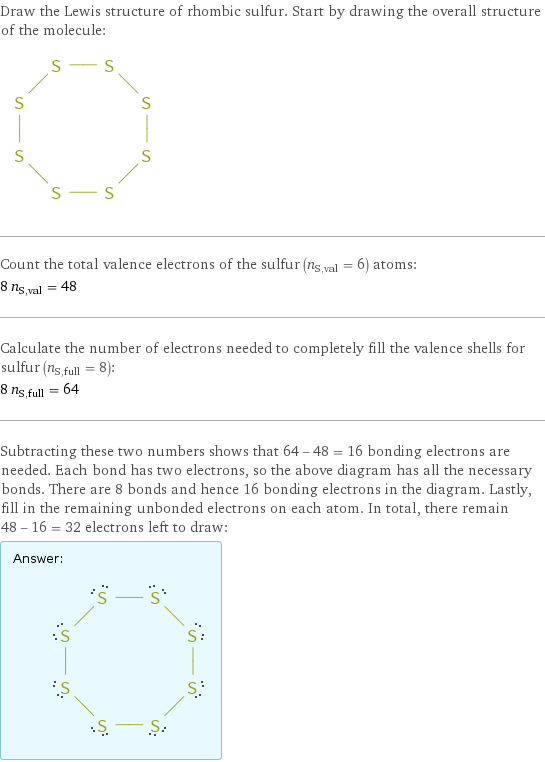Input interpretation

rhombic sulfur
Chemical names and formulas

formula | S_8 name | rhombic sulfur IUPAC name | octathiocane alternate names | alpha-sulfur | flowers of sulfur | milk of sulfur | Muthmann's sulfur I | orthorhombic sulfur mass fractions | S (sulfur) 100%
Lewis structure

Draw the Lewis structure of rhombic sulfur. Start by drawing the overall structure of the molecule: Count the total valence electrons of the sulfur (n_S, val = 6) atoms: 8 n_S, val = 48 Calculate the number of electrons needed to completely fill the valence shells for sulfur (n_S, full = 8): 8 n_S, full = 64 Subtracting these two numbers shows that 64 - 48 = 16 bonding electrons are needed. Each bond has two electrons, so the above diagram has all the necessary bonds. There are 8 bonds and hence 16 bonding electrons in the diagram. Lastly, fill in the remaining unbonded electrons on each atom. In total, there remain 48 - 16 = 32 electrons left to draw: Answer: | |
3D structure

3D structure
Basic properties

molar mass | 256.5 g/mol phase | solid (at STP) density | 2.07 g/cm^3
Units

Solid properties (at STP)

density | 2.07 g/cm^3
Units

Thermodynamic properties

specific heat capacity c_p | gas | 0.0924 J/(g K) | solid | 0.08812 J/(g K) molar heat capacity c_p | gas | 23.7 J/(mol K) | solid | 22.6 J/(mol K) specific free energy of formation Δ_fG° | gas | 0.9229 kJ/g molar free energy of formation Δ_fG° | gas | 236.7 kJ/mol specific heat of formation Δ_fH° | gas | 1.081 kJ/g | solid | 0 kJ/g molar heat of formation Δ_fH° | gas | 277.2 kJ/mol | solid | 0 kJ/mol specific entropy S° | gas | 0.6542 J/(g K) | solid | 0.1252 J/(g K) molar entropy S° | gas | 167.8 J/(mol K) | solid | 32.1 J/(mol K) (at STP)
Chemical identifiers

CAS number | 10544-50-0 PubChem CID number | 66348 SMILES identifier | S1SSSSSSS1 InChI identifier | InChI=1S/S8/c1-2-4-6-8-7-5-3-1